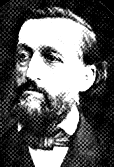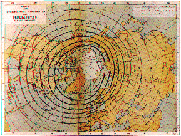|
[an error occurred while processing this directive]
#3b. Auroral Frequency Map by Hermann Fritz
|
(Files in red–history)
|
 Hermann Fritz Hermann FritzShown here is a map of the frequency with which auroras are seen, produced in 1881 by the German scientist Hermann Fritz (1830-1883). The line of greatest frequency lists 100 auroras per year, while in the center of the pattern auroras are much less frequent.
Click here for a full size version (232 K) of this image. If the Earth's field resembled that of a simple bar magnet ("dipole"), its magnetic pole would be near the northwestern tip of Greenland, in the middle of the pattern. However, the field contains additional complex parts, whose effect does not extend as far into space, and these shift the pole actually observed on the ground to northern Canada, to the location shown on the map.
|
|
Timeline Expanded timeline Glossary Author and Curator: Dr. David P. Stern
Re-formatted 3-10-2006 |

